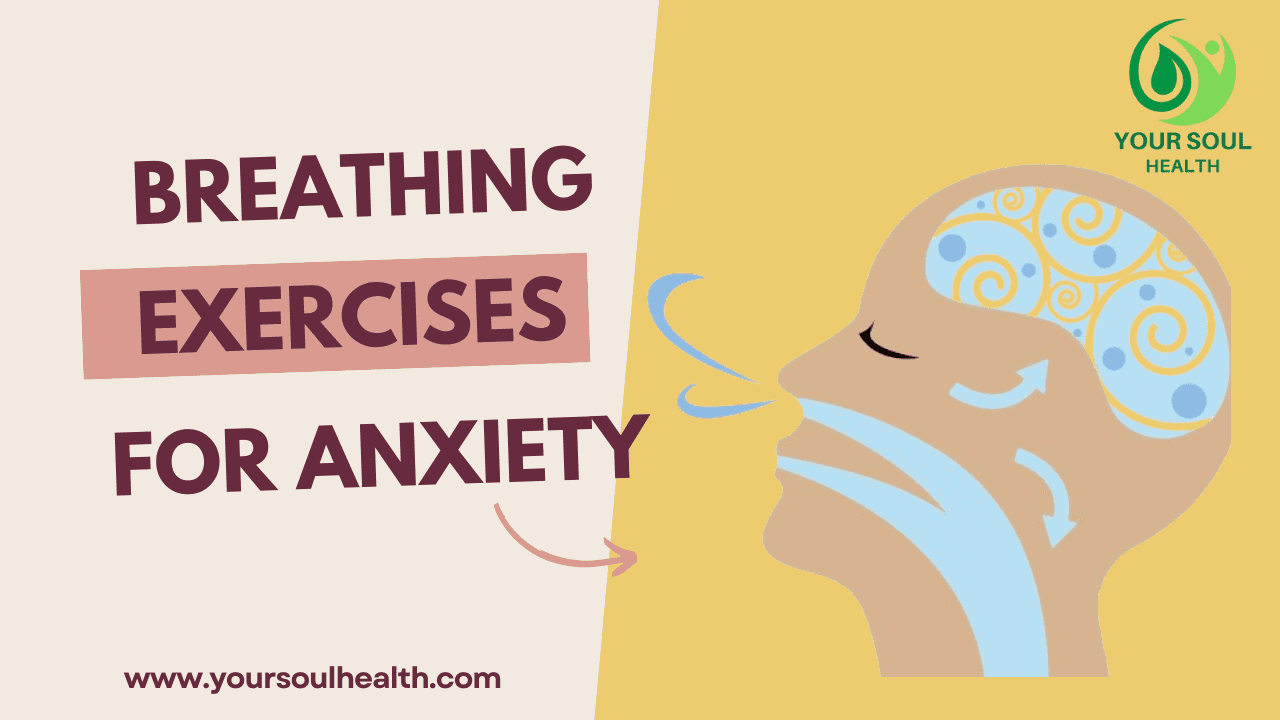Discover calming breathing exercises for anxiety relief. Learn techniques to soothe your mind and body. Breathing exercises can help reduce anxiety. Belly breathing and box breathing are effective methods.
When anxiety strikes, implementing breathing exercises can be a powerful tool for managing and reducing symptoms. By focusing on breath control, individuals can calm both the mind and body, alleviating the impact of anxiety. Various techniques, such as belly breathing, box breathing, and deep breathing through the nose and out through the mouth, have been shown to promote relaxation and reduce stress levels.
These exercises can be easily incorporated into daily routines and provide a practical and accessible way to help manage anxiety. In this guide, we’ll explore the effectiveness of breathing exercises in mitigating anxiety and how they can be integrated as a part of a holistic approach to mental well-being.
Understanding Anxiety And Breathing
Understanding and managing anxiety can be done through various breathing exercises. Try belly breathing by focusing on your breath or practice box breathing to calm your mind and body. These techniques can help relieve stress and promote relaxation.
The Connection Between Anxiety And Breathing
There is a strong connection between anxiety and breathing. When we experience anxiety, our body’s natural response is to activate the sympathetic nervous system, often referred to as the “fight-or-flight” response. This response causes our breathing to become shallow and rapid, leading to feelings of panic and further exacerbating our anxiety levels.
Impact Of Breathing On Anxiety Levels
The way we breathe directly impacts our anxiety levels. Shallow and rapid breathing can signal to our brain that there is danger, triggering further anxious thoughts and physical symptoms. On the other hand, slow and deep breathing activates the parasympathetic nervous system, which helps promote relaxation and calmness. By consciously focusing on our breath and practicing breathing exercises, we can effectively manage and reduce anxiety.
One effective breathing exercise for anxiety is belly breathing. Alternatively referred to as diaphragmatic breathing, this method is taking deep breaths into your abdomen as opposed to your chest. Here’s how you can do it:
- Find a comfortable position, whether it’s sitting or lying down.
- Put one hand on your belly and another on your chest.
- Inhale deeply and slowly through your nose. As you fill your lungs with air, feel your belly rise.
- Breathe out slowly through your lips, allowing your tummy to drop as you do so.
- Repeat this process several times, focusing on the sensation of your breath filling and leaving your body.
Belly breathing helps activate the relaxation response, counteracting the physical symptoms of anxiety such as rapid heartbeat and tension. It also helps calm the mind, bringing focus back to the present moment and reducing anxious thoughts.
Another effective breathing technique for anxiety is box breathing. Box breathing involves inhaling, holding the breath, exhaling, and holding the breath again in a series of equal counts, forming a square pattern. Here’s how you can practice box breathing:
- Locate a peaceful, cozy area where you can sit or lie down.
- As you count to four, carefully inhale through your nose.
- Hold your breath for a count of four.
- Breathe out slowly via your mouth while counting to four.
- Hold your breath again for a count of four.
- Repeat this sequence several times, maintaining an equal count for each phase.
Box breathing helps regulate and slow down your breath, promoting a sense of calmness and reducing anxiety. It can be an effective technique to use during moments of acute anxiety or as a daily practice to manage overall anxiety levels.
It’s important to note that everyone’s experience with anxiety is unique, and different breathing techniques may work better for some individuals than others. It may be helpful to experiment with different techniques and find the ones that resonate with you the most. Remember, practicing breathing exercises regularly can provide a powerful tool in managing anxiety and promoting overall well-being.
:max_bytes(150000):strip_icc()/3145195-article-tips-to-reduce-stress-5a8c75818e1b6e0036533c47-922c3155e9c846eaa7447c75030b2c13.png)
Credit: www.verywellmind.com
Popular Breathing Exercises
When it comes to managing anxiety, breathing exercises can play a crucial role in promoting relaxation and peace of mind. Popular breathing exercises such as belly breathing, box breathing relaxation techniques, and deep diaphragmatic breathing are effective tools to help calm the mind and reduce feelings of stress.
Belly Breathing Exercise
First, settle into a comfortable sitting or laying posture. Put a hand on your belly and another on your chest.
- Start to bring your attention to your breath, focusing on the rise and fall of your belly as you inhale and exhale.
- Take slow, deep breaths through your nose, allowing your belly to expand with each inhale.
- Feel your tummy tighten as you gently release the breath through your mouth.
Box Breathing Relaxation Technique
Box breathing is a simple yet powerful technique to calm the body and mind. It involves a pattern of breathing in, holding, breathing out, and holding, each for a count of four.
- What is Box Breathing?
- How to do box breathing:
- Inhale deeply for a count of four.
- Hold your breath for four counts.
- Exhale slowly for four counts.
- Hold your breath for four counts.
- Experience the physiological and psychological benefits of box breathing as it helps restore calmness and clarity.
Deep Diaphragmatic Breathing Exercise
Deep diaphragmatic breathing focuses on engaging the diaphragm to promote relaxation and reduce anxiety.
- Breathe in slowly through your nose, allowing the air to fill your lower lungs first and then your upper lungs.
- Take three deep breaths and hold them.
- Exhale slowly through your lips while relaxing your jaw, face, stomach, and shoulders.
Benefits Of Breathing Exercises
Breathing exercises are a simple and effective way to manage anxiety. They offer numerous benefits, both physiologically and psychologically, that can help individuals calm their minds and reduce stress levels.
Physiological Benefits
- Improved oxygen supply: Deep breathing enhances oxygen intake, promoting better blood circulation and overall health.
- Lowered heart rate: Controlled breathing techniques can help regulate the heart rate, reducing feelings of panic and stress.
- Relaxed muscles: Deep breathing encourages muscle relaxation, alleviating tension and promoting a sense of calmness.
Psychological Benefits
- Reduced anxiety: Breathing exercises have a calming effect on the mind, reducing feelings of anxiety and promoting mental clarity.
- Enhanced focus: Deep breathing techniques help improve concentration and focus by quieting the mind and reducing distractions.
- Stress relief: Regular practice of breathing exercises can lower cortisol levels, the stress hormone, leading to a more relaxed state of mind.
Tips For Effective Breathing
To effectively ease anxiety with breathing exercises, practice belly breathing by inhaling deeply through your nose and exhaling slowly through your mouth. Engage in box breathing, a technique that involves inhaling, holding, and exhaling in equal counts, to promote calmness.
These exercises can help alleviate stress and promote relaxation.
Breathing exercises are powerful tools for managing anxiety, promoting relaxation, and enhancing overall well-being. Here are some practical tips to make your breathing exercises more effective:
Creating A Comfortable Environment
Take note of how air comes into and goes out of your body. Locate an area that is calm and quiet where you can comfortably sit or lie down. Eliminate distractions and create a cozy atmosphere to enhance relaxation.
Focusing On Breath Awareness
Direct your attention to your breath. Notice the sensation of air entering and leaving your body. Stay present in the moment and focus on the rhythm of your breathing.
Dealing With Intrusive Thoughts
When intrusive thoughts arise, acknowledge them without judgment. Gently shift your focus back to your breath, allowing the thoughts to pass without getting caught up in them.
Remember, consistent practice is key to reaping the full benefits of breathing exercises. Incorporate these tips into your routine for a more effective and calming experience.
Using Breathing To Relieve Stress And Anxiety
Relieve stress and anxiety with simple breathing techniques. Practice belly breathing by bringing your attention to your breath and allowing thoughts to come and go. Try box breathing to calm feelings of anxiety and enjoy the physiological and psychological benefits.
Influence Calmness Through Breathing
Slow, steady, and deep breathing is one of the most effective ways to calm the mind and body when feeling anxious or stressed. By actively engaging in mindful breathing exercises, individuals can develop a sense of calmness and reduce the overwhelming feelings associated with anxiety. With proper techniques, breathing provides a powerful tool to regain control over intrusive thoughts and emotions.
Ensure Grounding With Deep Breaths
Deep breaths facilitate a connection between the mind and body, ensuring grounding and balance during times of heightened anxiety. By focusing on deep, intentional breathing, individuals can effectively realign their attention from distressing thoughts to the soothing rhythm of their breath. This practice fosters a sense of control and stability, empowering individuals to manage their anxiety with self-awareness and mindfulness.

Credit: www.happify.com
Professional Perspectives On Breathing Exercises
Professional perspectives on breathing exercises offer valuable insights for managing anxiety. Medical professionals and mental health experts often recommend various breathing exercises as an effective tool for combating anxiety. Let’s delve into the recommendations and insights provided by these professionals to understand the significance of incorporating breathing exercises into anxiety management.
Insights From Medical Professionals
Medical professionals emphasize the physiological benefits of breathing exercises in managing anxiety. They explain that controlled breathing techniques can trigger the body’s relaxation response, leading to decreased heart rate, lower blood pressure, and reduced stress hormones.
- Belly breathing exercise helps in calming the body and mind by focusing attention on the breath and acknowledging passing thoughts without judgment.
- Box breathing relaxation technique is recommended for calming feelings of anxiety. It involves a structured breathing pattern to induce physical and psychological benefits, promoting relaxation.
- Breathing to Influence Calmness technique is advised, emphasizing slow inhalation, brief breath retention, and gentle exhalation to induce a sense of calmness.
Recommendations From Mental Health Experts
Mental health experts stress the psychological aspect of breathing exercises in managing anxiety. They emphasize that deep breathing techniques can divert attention from anxious thoughts, increase mindfulness, and promote a sense of calmness and control.
- Breathing exercises for stress recommended by NHS involve deep belly breathing, emphasizing a gentle and regular breathing pattern to ease stress.
- Engaging in Lion’s Breath exercise, as suggested by Verywell Mind, involves inhaling through the nose and exhaling with an open mouth and tongue stretch to release tension and promote relaxation.
Finding The Best Breathing Exercises
Enhance calmness and reduce anxiety with effective breathing exercises. Try belly breathing or the box breathing technique for relaxation. Take control of your breath to influence a sense of peace and well-being.
Expert Opinions On Effectiveness
Breathing exercises have been widely recommended as an effective tool for managing anxiety. Experts in the field have weighed in on the effectiveness of these exercises and their positive impact on mental well-being.
According to the Indiana University School of Medicine, one popular breathing exercise is belly breathing. In a YouTube video, they explain that this exercise involves getting comfortable and bringing attention to the breath. They reassure viewers that it’s normal for thoughts to come into the mind during the practice. This exercise allows individuals to calm both their body and mind, promoting a sense of relaxation and reducing anxiety levels.
Another breathing exercise that experts recommend is box breathing, as highlighted by Sunnybrook Hospital. In their YouTube video, they describe box breathing as a relaxation technique that helps to calm feelings of anxiety. Physiological and psychological benefits are also associated with this exercise. They explain that box breathing involves inhaling, holding the breath, exhaling, and holding the breath again in a pattern resembling the shape of a box.
Personal Experiences And Testimonials
Many individuals have experienced positive results from incorporating breathing exercises into their anxiety management routines. Numerous testimonials and personal experiences suggest that these exercises can be highly effective in reducing anxiety and stress levels.
AskDoctorJo, a popular YouTube channel, features a video showcasing simple breathing techniques to relieve stress and anxiety. The video highlights various exercises, including deep belly breathing and calming breath influence. These exercises involve gently breathing in, holding the breath briefly, and gradually exhaling while relaxing the body and mind. The host, Dr. Jo, shares how these techniques have helped many of her patients cope with anxiety and achieve a greater sense of calmness.
Additionally, reputable sources like Calm.com offer detailed information on breathing exercises for anxiety. Their blog post emphasizes the importance of deep breathing, with a focus on inhaling through the nose and exhaling through the mouth. These techniques are known to promote relaxation and reduce anxiety symptoms, providing individuals with a sense of control over their breathing and emotions.
Overall, both expert opinions and personal experiences highlight the effectiveness of breathing exercises in managing anxiety. Whether it’s belly breathing, box breathing, or other techniques, practising these exercises can have a significant impact on mental well-being, offering a valuable tool for individuals seeking relief from anxiety.
Exploring Additional Resources
Discover a variety of breathing exercises to alleviate anxiety. Practice belly breathing and box breathing techniques for calming the mind and body. Learn how specific breathing methods can help you overcome feelings of stress and anxiety.
Youtube Tutorials
Explore diverse breathing exercise resources through YouTube tutorials.
- Find step-by-step guides from experts in anxiety management.
- Benefit from visual demonstrations for effective anxiety-relief techniques.
Online Articles And Guides
Discover informative articles and guides for breathing exercises online.
- Access in-depth explanations on the science behind anxiety and breathing.
- Learn about various breathing techniques tailored for anxiety management.

Credit: www.healthline.com
Frequently Asked Questions For Breathing Exercises For Anxiety
What Is The 4 7 8 Breathing Technique?
The 4 7 8 breathing technique is a relaxation exercise for anxiety. Breathe in by your nose for four counts, hold it for seven counts, and then release the breath through your mouth for eight counts. For a soothing effect, repeat as necessary.
What Is The Best Breathing Exercise For Anxiety?
The best breathing exercise for anxiety is belly breathing. Start by getting comfortable, focusing on your breath, and exhaling slowly to calm your mind and body. Box breathing is also effective for calming feelings of anxiety. It involves slow, deep breaths and has physiological and psychological benefits.
What Is 3 3 3 Breathing For Anxiety?
3 3 3 Breathing for anxiety involves inhaling deeply for 3 seconds, holding for 3 seconds, and exhaling for 3 seconds to reduce stress and promote relaxation.
How Do I Overcome Breathing Anxiety?
To overcome breathing anxiety, try these breathing exercises: 1. Belly Breathing: Get comfortable, focus on your breath, and let thoughts come and go. 2. Box Breathing: Inhale slowly through your nose, hold for three seconds, exhale through your lips, and relax.
3. Deep Diaphragmatic Breathing: Breathe in through your nose, let your belly fill with air, and exhale through your mouth. These exercises can help calm your body and mind, relieving stress and anxiety.
Conclusion
Incorporating breathing exercises into your daily routine can be a powerful tool in managing anxiety. Belly breathing and box breathing are two effective techniques that promote relaxation and calming of the mind and body. By focusing on your breath and allowing it to flow deep into your belly, you can alleviate stress and anxiety.
Practice these exercises regularly to experience the physiological and psychological benefits they offer. Don’t let anxiety control you – take control of your breath and find relief.

I am a health writer and blogger based in the US and UK. I have been with the health department for six years. And I give advice on various health problems and solutions. I have a lot of experience in health matters and I share it here.

